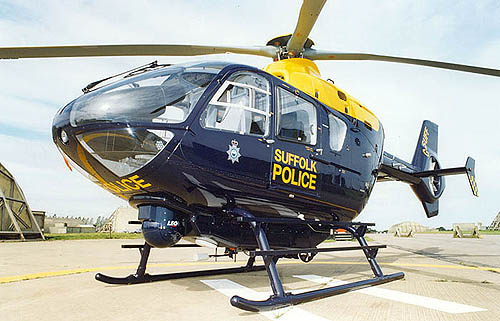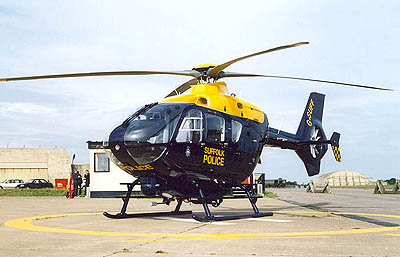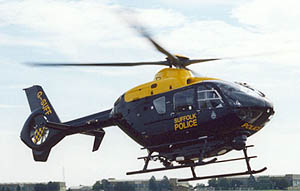![]()
 Spotlight: It's a
fair cop at Wattisham...
Spotlight: It's a
fair cop at Wattisham...
Dave Eade looks at a new force resident at the base. All pictures courtesy of Suffolk Constabulary
Arriving on October 2nd 2000, not the latest version of Boeing’s electronic spy-bird but over £2 million worth of helicopter in the shape of a Eurocopter EC135, fully equipped for all the tasks that face the new Air Support Unit (ASU) of Suffolk Constabulary.
Funded jointly by HM Government and Suffolk Police, EC135 (reg. G-SUFF) is now stationed at Wattisham Airfield, using one hangar of the old 74 Squadron HAS site on the north side of the airfield. A purpose built office unit houses the shift crews drawn from three civilian pilots, nine observers and an engineer. From this building, the ASU covers the whole of Suffolk, Essex and Cambridgeshire with the two neighbouring forces on a consortium basis allowing any of the three to respond to a demand. This demand can come from any police officer, regardless of rank, who may call direct to the Operations Room of the ASU.
The EC135 was originally designed as a twin-engined,
seven-seater general-purpose helicopter. As supplied to Suffolk ASU by
McAlpine Helicopters, G-SUFF has an equipment pod under the main cockpit
– giving the helicopter a certain pregnant or tadpole look. In providing
a home for some of the equipment, the pod allows more cockpit room – room
to put a video camera, thermal imaging system and a microwave down-link
which allows video information to be sent in real-time to forces on the
ground. Thermal imaging has reached very high sophistication today. If
a dog fouls the pavement, not only can the police detect the heat source
but also the location down to the house number and street, which can be
downloaded to a colleague sat in the back of a patrol car – not much chance
for the fugitive then! A powerful loudhailer, searchlight  and a moving map display aid the ASU
in their tasks of search, pursuit, command and control, rapid response,
traffic management, evidence gathering and photography.
and a moving map display aid the ASU
in their tasks of search, pursuit, command and control, rapid response,
traffic management, evidence gathering and photography.
Although new to Suffolk, the idea of Air Support for the police goes back to the thirties when, for many years, aircraft had to be chartered on an ad-hoc basis. Only five of the English and Welsh forces now do not have the facility of air support, so what are the great advantages?
- When searching areas of ground (particularly in a rural setting) one helicopter can do the work of hundreds of officers in a fraction of the time.
- The ability to search and pursue from the safety of the air decreases the risk to officers on the ground.
- The time taken to put sophisticated surveillance equipment on the incident scene in reduced to a fraction of that required by automobiles.
- As a PR exercise the sight of police presence in the air can be seen as reassurance to those on the ground whether public or officers in the field.
So what happens?
An officer at any incident decides that Air
Support can assist the task in hand, be it crime scene, natural emergency
or the need to assess a large geographic area in hurry. A phone call to
the Operations Room of Air Support or a spontaneous decision by the ASU
crews listening all the time to police radio frequencies starts the launch
procedure. As previously described no authority other than that of the
ASU crew themselves is needed for launch.  Final decision to launch, with input from pilot as to
safety (and legality) is made by the crew, again with no reference up
the rank chain. This lack of bureaucracy speeds the process and limits
the time wasted between initiation and take-off. From take-off the EC-135
can be at the northernmost point of the area (Lowestoft) in less than
twenty minutes using its top speed of over 150 mph.
Final decision to launch, with input from pilot as to
safety (and legality) is made by the crew, again with no reference up
the rank chain. This lack of bureaucracy speeds the process and limits
the time wasted between initiation and take-off. From take-off the EC-135
can be at the northernmost point of the area (Lowestoft) in less than
twenty minutes using its top speed of over 150 mph.
All three pilots are civilians on contract to Suffolk Police from Aeromega Aviation. Coming to the force from sources such as RAF Search and Rescue and Army Air Corps backgrounds, all were converted to the EC135 at McAlpine’s Kidlington base in Oxfordshire. Air Support project manager Superintendent Carl Puiy said: "A lot of work has been put into setting up the base - and it has progressed very well. We had to have not only planning permission for the base but also ministerial permission. A joint operational working agreement has been drawn up with the military and a ten year lease for the base has been formally signed. Wattisham is the ideal base. Not only is it a well established helicopter base but its position means that our aircraft will be able to reach all parts of the county quickly."
So a further chapter is written in Wattisham’s history. Always a base with close contact with the public never more so than now when at a call the Suffolk Air Support Unit is there – not just to support the Police but the public at large.
Air-Scene UK would like to express its appreciation to the men of the Suffolk ASU for their interest and support in compiling this report.